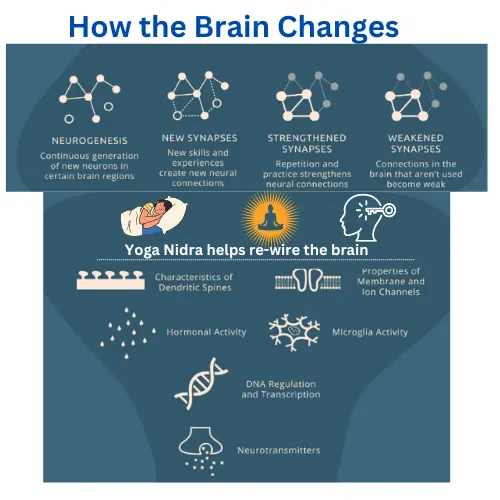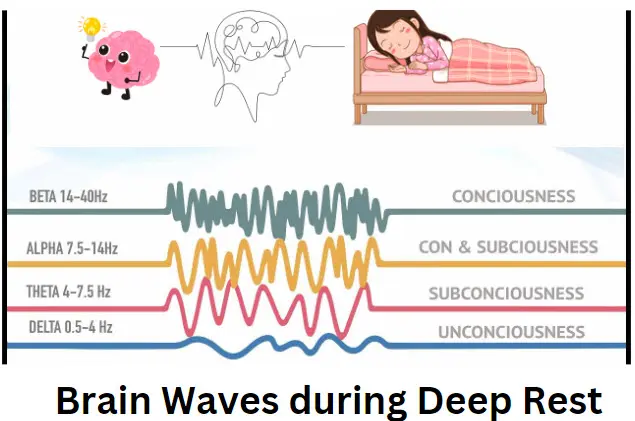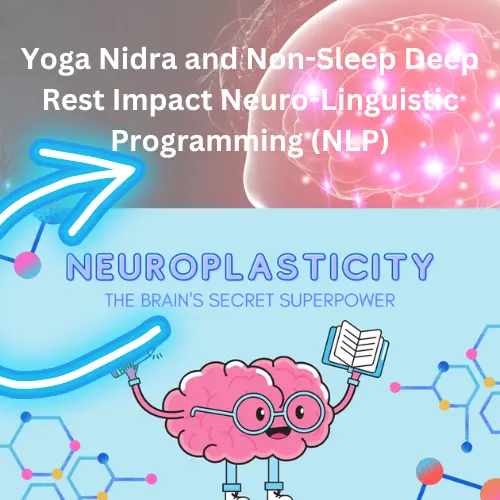Neuro Lingustic Programming- NLP achieved through Yoga Nidra & NSDR: Best Practices
In this blog post, we delve into the fascinating realms of the mind-body connection, specifically exploring the profound influence of Yoga Nidra and Non-Sleep Deep Rest on Neuro-Linguistic Programming (NLP). In simpler words Yoga Nidra can help you tap in to your sub conscious and re-wire your brain. Yoga Nidra can be thought of the practice that help you connect the “thinking mind to the feeling body”. Our daily lives is filled with work, stress, checklist of things to do and Instagram feeds.. It’s almost impossible to connect with your self/sub-consciouswhen in a state of continous activity ( “thinking state”). Yoga Nidra helps you take you into a DEEP Rest state through body scans. Once in a state of deep rest, you can grow and achieve and can make shifts in their consciousness.
The thinking body is a storehouse of emotion, feelings, intuitions and inner guidance. It will take you where you need to go without the fear. The Yoga Nidra AUDIO is an INSTRUMENT, to plant the seeds in a state of deep rest and help you move towards change.

EXPLORING The Mind-Body Connection through NLP and Yoga Nidra
The mind and body are intimately interconnected, inextricably woven into the intricate fabric of our existence. This age-old understanding is gaining renewed attention in the realms of holistic healing and personal growth. The mind influences the body, and the body, in turn, shapes the mind.
Yoga nidra ( or sleep of the Yogis) is a system of physical and mental practices originating in ancient India, not only emphasizes physical well-being but also recognizes the profound effects of the mind on one’s overall health and vitality. Through body scans, breath control, and meditation, practitioners seek to cultivate harmony between the mind, body, and spirit.

Brain Waves and Science of re-wiring the brain through Yoga Nidra:
There are five types of brain waves, and understanding them is crucial for those practicing not only yoga nidra but any kind of meditation, or pranayam. These brain waves influence our state of mind.
Types of Brain Waves:
Beta (14-40Hz): Associated with alertness and critical reasoning, but can also lead to stress and anxiety. Most adults predominantly operate in this state.
Alpha (7.5-14Hz): Represents a relaxed state, often associated with daydreaming, meditation, and deep relaxation. It is the gateway to the subconscious mind and enhances imagination, visualization, and concentration.
Theta: Occurs during sleep and deep meditation. It is linked with vivid imagery, intuition, and deep emotions. In this state, one can experience a profound connection with the universe and consciously create reality.
Delta: The slowest frequency, experienced during deep, dreamless sleep or in a deep meditative state. It is vital for healing and regeneration.
Gamma (above 40Hz): The fastest frequency, associated with bursts of insight and high-level information processing. Predominantly found in highly spiritual individuals, it is linked with heightened compassion, happiness, and acute mental abilities.
Brain Waves and Activities: Each brain wave is associated with specific states and activities. For instance, a person in active conversation is in the beta state, while one in deep relaxation is in the alpha state.
Relation to Yoga Nidra: Unlike regular sleep, where one transitions from beta directly to delta, Yoga Nidra promotes an extended alpha state, which denotes relaxation. This form of relaxation ensures that practitioners wake up feeling refreshed and rejuvenated.
With Sleep Draogn we help you understand and harnessing the power of brain waves can lead to a more profound state of relaxation, insight, and overall well-being. Yoga Nidra, in particular, offers a unique platform for achieving this deep relaxation.
Yoga Nidra & NSDR: A Gateway to Deep Rest
Contrary to its name, Yoga Nidra is not a state of sleep but a state of heightened awareness and deep relaxation. It allows individuals to enter a state of conscious deep sleep while remaining fully awake.
Yoga Nidra induces a profound physical and mental relaxation response, activating the parasympathetic nervous system – the body’s “rest and digest” mode. By entering this deep state of relaxation, the body is able to restore and heal itself, reducing stress and anxiety, improving sleep quality, and nurturing overall well-being.

Neuro-Linguistic Programming (NLP): Unleashing Human Potential
On the other side of the spectrum, we have Neuro-Linguistic Programming (NLP), a psychological approach that explores the relationship between our thoughts, language, and patterns of behavior. NLP offers a set of tools and techniques to reprogram the mind, enabling individuals to overcome limiting beliefs and create positive change in their lives.
NLP practitioners recognize that our internal representations – the way we perceive and interpret the world around us – greatly impact our thoughts, emotions, and actions. By understanding and reshaping these internal representations, individuals can enhance their mental and emotional well-being, improve communication skills, and unlock their full potential.
The Nexus: Yoga Nidra and NLP and how you can help re-program the sub-conscious
So, how do Yoga Nidra and NLP intersect? Both approaches share a common goal – the cultivation of optimal mental and physical states that facilitate healing, personal growth, and overall well-being. When combined, they create a synergistic effect, enhancing each other’s benefits.
YOGA NIDRA TIPS AND WORKINGS
Yoga Nidra, with its ability to induce deep relaxation and access subconscious realms, creates a fertile ground for the application of NLP techniques. In this heightened state of awareness, individuals can tap into their deepest emotions, beliefs, and patterns of behavior, allowing for more profound transformations.
Similarly, NLP techniques can enrich the practice of Yoga Nidra. The use of language patterns, visualizations, and anchoring techniques can deepen the experience of Yoga Nidra, amplifying its effects on the mind and body. By employing NLP strategies during Yoga Nidra, practitioners can effectively rewire their thinking patterns and enhance the benefits of this deeply restorative practice.

Unlocking the Potential: Yoga Nidra and NLP in Practice
For yoga and spirituality practitioners, integrating NLP techniques into their Yoga Nidra practice can provide a powerful catalyst for personal growth and transformation. By identifying and releasing limiting beliefs and negative thought patterns, individuals can experience a profound shift in their perception, opening up new possibilities for self-realization and spiritual evolution.
On the other hand, anxious corporate workers can find solace and rejuvenation through the combined practice of Yoga Nidra and NLP. By consciously relaxing and exploring their inner landscape, they can recalibrate their nervous system, reduce stress, and enhance their overall mental and emotional resilience. This integrated approach offers a unique method for self-care and empowerment amidst the pressures of a demanding corporate environment.
HOW THE UNLOCKING OF THE MIND WORKS THROUGH YOGA NIDRA
Remember, the mind and body are not separate entities but rather a dynamic duo engaged in a perpetual dance. By embracing practices such as Yoga Nidra and Neuro-Linguistic Programming, we unlock the immense potential of this mind-body connection, paving the way for personal transformation and holistic well-being. Sundar Pichai CEO Of Google practices Yoga Nidra/NSDR as a way for deep rest and also improving focus and productivity

So, step onto the mat or find a cozy corner, and embark on this transformative journey – where Yoga Nidra and NLP intersect, revealing the boundless possibilities of the mind and body.


